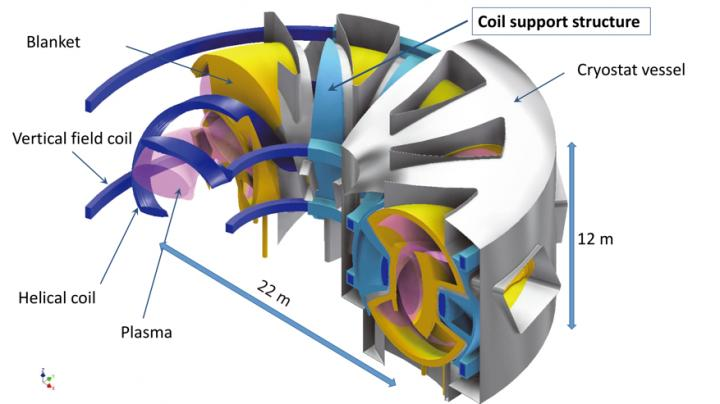Jun 30 2020
The method of topology optimization was initially applied to the conceptual design of a helical fusion reactor, the aim of which is to demonstrate the generation of power.
 The superconducting coil consists of two pairs of helical coils and two sets of circular vertical magnetic field coils. In order to prevent the coil from moving or deforming due to the strong electromagnetic force acting on the superconducting coils, it is firmly supported by a supporting structure made of stainless steel with a high strength of 20 cm thick. These superconducting coils and supporting structures are cooled to cryogenic temperatures simultaneously. Image Credit: National Institute for Fusion Science.
The superconducting coil consists of two pairs of helical coils and two sets of circular vertical magnetic field coils. In order to prevent the coil from moving or deforming due to the strong electromagnetic force acting on the superconducting coils, it is firmly supported by a supporting structure made of stainless steel with a high strength of 20 cm thick. These superconducting coils and supporting structures are cooled to cryogenic temperatures simultaneously. Image Credit: National Institute for Fusion Science.
This application was carried out by the team of associate professor Hitoshi Tamura and others from the National Institute of Natural Sciences (NINS) National Institute for Fusion Science (NIFS). Through this method, the researchers effectively realized a weight reduction of around 2000 tons of the support structure covering helically twisted coils, but without affecting the robustness of the structure.
A magnetic fusion power reactor can be achieved only with a superconducting coil. Plasma within this magnetic fusion power reactor should be confined by a powerful magnetic field. Made of a superconducting conductor, the superconducting coil is wound several hundred times. When a massive current flow of around 100 kA passes through the coil, it produces a powerful magnetic field.
When a magnetic field acts on a coil where there is a flow of electric current, this results in the generation of electromagnetic force. The resultant electromagnetic force is so huge that even the superconducting coil cannot endure this force.
To make sure that the coil does not deform or move drastically, it should be firmly surrounded with a structure composed of a robust material. This structure, known as a coil support structure, supports the coil.
To date, researchers have estimated that the weight of the coil support structure of the helical fusion reactor is 1.6 times heavier than that of the International Thermonuclear Experimental Reactor (ITER) and 20 times that of the Large Helical Device (LHD).
Moreover, the superconducting coils are used at cryogenic conditions (less than –260 °C), and hence, the solid and heavy coil support structure should also be cooled to the same level of temperature as the coils. This would allow the coils to be maintained in the superconducting state.
Considering the cost and power consumption, decreasing the amount of materials is a very crucial problem. Researchers strongly prefer to decrease the overall weight of the coil support structure as much as possible, while making sure that the coil is not affected. To overcome this problem, the scientists used the “topology optimization method” on the concept design of the coil support structure.
Topology optimization can be described as an analytical technique used to decrease the volume of the structure by eliminating the portion that does not impact the strength. This method is similar to looking for the improved shape from numerous combinations, such as the topology change. Such a technique offers the possibility to produce shapes that cannot be envisioned on the basis of traditional designs.
This technique has advanced quickly in recent years, since it can effectively reduce the cost and weight, like automobile parts. But there were no application examples where the topology optimization method has been used on the overall design of a part used in the fusion reactor.
For the first time, the researchers used the topology optimization technique on the overall design of the structure in a large and complex fusion reactor to decrease its weight. The strength of the structure is determined by the stress force working in the structure.
The structure will begin to break if the stress happens to be greater than the tolerable level of the component material. Structures should be optimized so that the stress does not surpass the tolerable levels by decreasing weight.
The researchers thoroughly examined the level at which stress and deformation are likely to act on the coil support structure caused by the electromagnetic force that acts on the coil.
Topology optimization was subsequently applied to the model. In the topology optimization method, the model is split into several tiny regions, followed by calculating the extent of impact on the overall strength upon removing a specific region.
A series of regions that can be eliminated without any kind of effects is ultimately established. In this manner, the researchers identified the optimum shape that does not impact the total strength and has also decreased weight. The weight of the coil support structure was therefore effectively decreased by around 25% from 7800 tons.
In the days to come, the fusion reactor design research done through the topology optimization technique is anticipated to make more advances, allowing the researchers to considerably approach the demonstration of the fusion reactor.
Journal Reference:
Tamura, H., et al. (2020) Topology optimization for superconducting magnet system in helical fusion reactor. doi.org/10.1088/1742-6596/1559/1/012108.